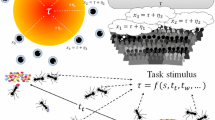Abstract
As research expands in multiagent intelligent systems, investigators need new tools for evaluating the artificial societies they study. It is impossible, for example, to correlate heterogeneity with performance in multiagent robotics without a quantitative metric of diversity. Currently diversity is evaluated on a bipolar scale with systems classified as either heterogeneous or homogeneous, depending on whether any of the agents differ. Unfortunately, this labeling doesn't tell us much about the extent of diversity in heterogeneous teams. How can it be determined if one system is more or less diverse than another? Heterogeneity must be evaluated on a continuous scale to enable substantive comparisons between systems. To enable these types of comparisons, we introduce: (1) a continuous measure of robot behavioral difference, and (2) hierarchic social entropy, an application of Shannon's information entropy metric to robotic groups that provides a continuous, quantitative measure of robot team diversity. The metric captures important components of the meaning of diversity, including the number and size of behavioral groups in a society and the extent to which agents differ. The utility of the metrics is demonstrated in the experimental evaluation of multirobot soccer and multirobot foraging teams.
Similar content being viewed by others
References
Arkin, R.C., Balch, T., and Nitz, E. 1993. Communication of behavioral state in multi-agent retrieval tasks. In Proceedings 1993 IEEE Conference on Robotics and Automation, Atlanta, GA.
Bailey, K. 1990. Social Entropy Theory, State University of New York Press: Albany.
Balch, T. 1997. Learning roles: Behavioral diversity in robot teams. In AAAI-97 Workshop on Multiagent Learning, Providence, RI. AAAI.
Balch, T. 1998. Behavioral diversity in learning robot teams. Ph.D. Thesis, College of Computing, Georgia Institute of Technology.
Balch, T. 1999. The impact of diversity on performance in multirobot foraging. In Proc.Autonomous Agents 99, Seattle, WA.
Balch, T., Boone, G., Collins, T., Forbes, H., MacKenzie, D., and Santamar´?a, J. 1995. Io, Ganymede and Callisto—A multiagent robot trash-collecting team. AI Magazine, 16(2):39–51.
Demetrius, L. 1992. The thermodynamics of evolution. Physica A, 189(3–4):417–436.
Fontan, M. and Mataric, M. 1997. A study of territoriality: The role of critical mass in adaptive task division. In From Animals to Animats 4: Proceedings of the Fourth International Conference of Simulation of Adaptive Behavior, MIT Press, pp. 553–561.
Goldberg, D. and Mataric, M. 1997. Interference as a tool for designing and evaluating multi-robot controllers. In Proceedings, AAAI-97, pp. 637–642.
Jardine, N. and Sibson, R. 1971. Mathematical Taxonomy, John Wiley & Sons.
Kitano, M., Asada, M., Kuniyoushi, Y., Noda, I., and Osawa, E. 1997. Robocup: The robot world cup initiative. In Proc.Autonomous Agents 97, Marina Del Rey, California.
Lurie, D., Valls, J., and Wagensberg, J. 1983. Thermodynamic approach to biomass distribution in ecological systems. Bulletin of Mathematical Biology, 45(5):869–872.
Lurie, D. and Wagensberg, J. 1980. Information theory and ecological diversity. In Systems Far from Equilibrium, L. Garrido (Ed.), Springer-Verlag: Berlin, West Germany, pp. 290–303. Sitges Conf. on Statistical Mechanics.
MacKenzie, D., Arkin, R., and Cameron, J. 1997. Multiagent mission specification and execution. Autonomous Robots, 4(1):29–52.
Magurran, A.E. 1988. Ecological Diversity and Its Measurement, Princeton University Press.
Mataric, M. 1992. Designing emergent behaviors: From local interactions to collective intelligence. In Proceedings of the International Conference on Simulation of Adaptive Behavior: From Animals to Animats 2, pp. 432–441.
Mataric, M. 1994. Learning to behave socially. In Proceedings of the International Conference on Simulation of Adaptive Behavior: From Animals to Animats 3.
Matari´c, M. 1997. Reinforcement learning in the multi-robot domain. Autonomous Robots, 4(1):73–83.
Meyer, P. and McIntosh, S. 1992. The USA Today index of ethnic diversity. International Journal of Public Opinion Research, 4(1):56–58.
Merriam-Webster 1989. Webster's Ninth New Collegiate Dictionary, Merriam-Webster.
Parker, L.E. 1994. Heterogeneous multi-robot cooperation. Ph.D. Thesis, M.I.T. Department of Electrical Engineering and Computer Science.
Press, W., Teukolsky, S., Vetterling, W., and Flannery, B. 1988. Numerical Recipes in C, Cambridge University Press.
Shannon, C.E. 1949. The Mathematical Theory of Communication, University of Illinois Press.
Sneath, P. and Sokal, R. 1973. Numerical Taxonomy, W.H. Freeman and Company: San Francisco.
Christopher, W.J.C.H. and Dayan, P. 1992. Technical note: Q learning. Machine Learning, 8:279–292.
Wilson, E.O. 1992. The Diversity of Life, Norton.
Author information
Authors and Affiliations
Rights and permissions
About this article
Cite this article
Balch, T. Hierarchic Social Entropy: An Information Theoretic Measure of Robot Group Diversity. Autonomous Robots 8, 209–238 (2000). https://doi.org/10.1023/A:1008973424594
Issue Date:
DOI: https://doi.org/10.1023/A:1008973424594




